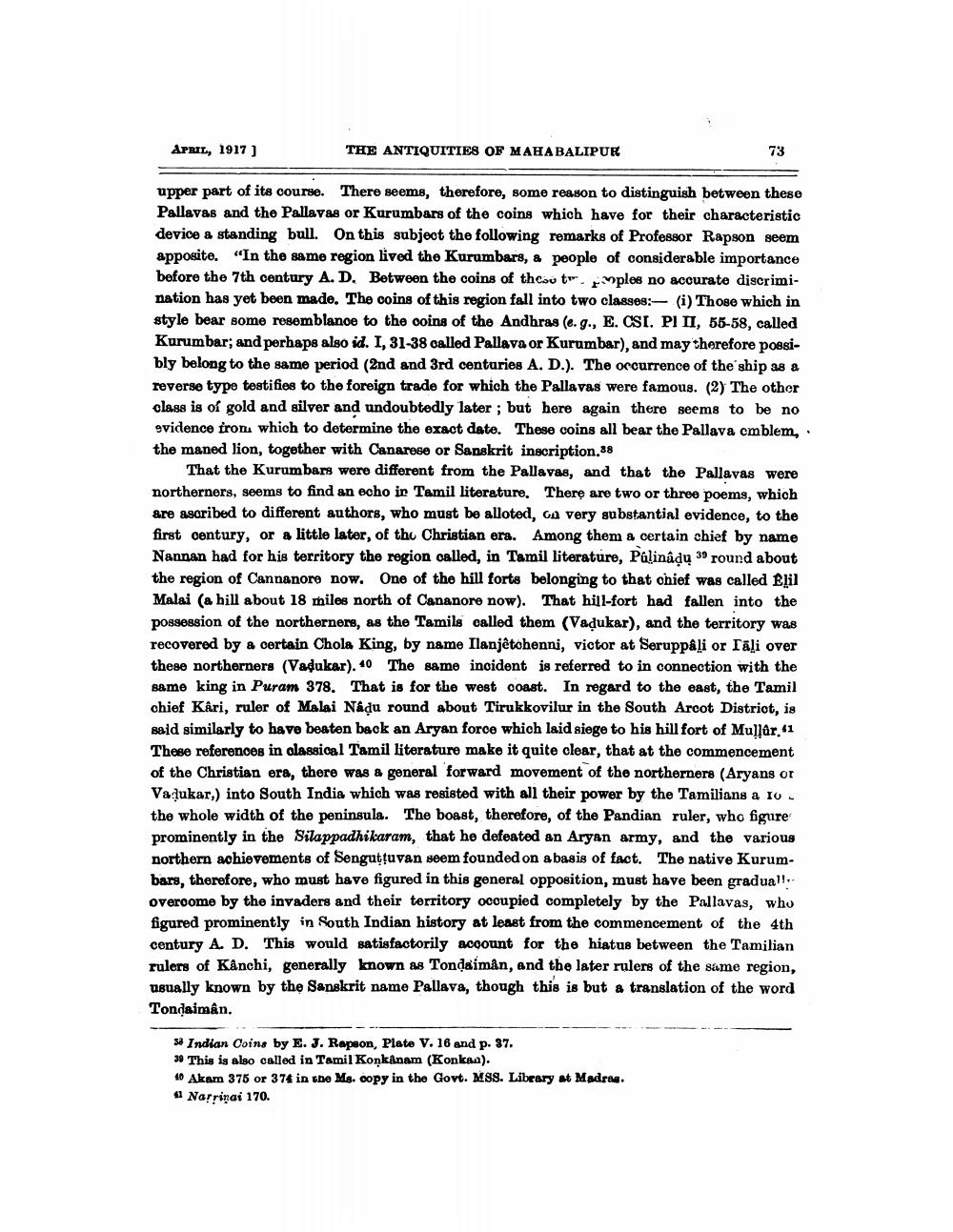________________
APRIL, 1917]
THE ANTIQUITIES OF MAHABALIPUR
73
upper part of its course. There seems, therefore, some reason to distinguish between these Pallavas and the Pallavas or Kurumbars of the coins which have for their characteristic device a standing bull. On this subject the following remarks of Professor Rapson seem apposite. "In the same region lived the Kurumbars, a people of considerable importance before the 7th century A. D. Between the coins of these toples no accurate discrimination has yet been made. The coins of this region fall into two classes: (i) Those which in style bear some resemblance to the coins of the Andhras (e. g., E. CSI. Pl II, 55-58, called Kurumbar; and perhaps also id. I, 31-38 called Pallava or Kurumbar), and may therefore possibly belong to the same period (2nd and 3rd centuries A. D.). The occurrence of the ship as a reverse type testifies to the foreign trade for which the Pallavas were famous. (2) The other class is of gold and silver and undoubtedly later; but here again there seems to be no evidence from which to determine the exact date. These coins all bear the Pallava emblem, the maned lion, together with Canarese or Sanskrit inscription.38
That the Kurumbars were different from the Pallavas, and that the Pallavas were northerners, seems to find an echo in Tamil literature. There are two or three poems, which are ascribed to different authors, who must be alloted, on very substantial evidence, to the first century, or a little later, of the Christian era. Among them a certain chief by name Nannan had for his territory the region called, in Tamil literature, Pálinâḍu 39 round about the region of Cannanore now. One of the hill forts belonging to that chief was called Elil Malai (a hill about 18 miles north of Cananore now). That hill-fort had fallen into the possession of the northerners, as the Tamils called them (Vaḍukar), and the territory was recovered by a certain Chola King, by name Ilanjêtchenni, victor at Seruppâli or Iāli over these northerners (Vadukar). 10 The same incident is referred to in connection with the same king in Puram 378. That is for the west coast. In regard to the east, the Tamil chief Kâri, ruler of Malai Nâḍu round about Tirukkovilur in the South Arcot District, is said similarly to have beaten back an Aryan force which laid siege to his hill fort of Mullûr. 41 These references in classical Tamil literature make it quite clear, that at the commencement of the Christian era, there was a general forward movement of the northerners (Aryans or Vadukar,) into South India which was resisted with all their power by the Tamilians a 10 the whole width of the peninsula. The boast, therefore, of the Pandian ruler, who figure prominently in the Silappadhikaram, that he defeated an Aryan army, and the various northern achievements of Senguṭṭuvan seem founded on a basis of fact. The native Kurumbars, therefore, who must have figured in this general opposition, must have been gradual! overcome by the invaders and their territory occupied completely by the Pallavas, who figured prominently in South Indian history at least from the commencement of the 4th century A. D. This would satisfactorily account for the hiatus between the Tamilian rulers of Kânchi, generally known as Tonḍaimân, and the later rulers of the same region, usually known by the Sanskrit name Pallava, though this is but a translation of the word Tonḍaimân.
38 Indian Coins by E. J. Rapson, Plate V. 16 and p. 37.
39 This is also called in Tamil Konkanam (Konkan).
40 Akam 375 or 374 in the Ms. copy in the Govt. MSS. Library at Madras. Naṛrinai 170.




